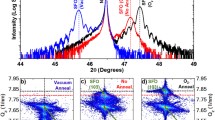Abstract
Non-stoichiometry in ternary oxide perovskites is analyzed to examine its donor/acceptor-like behavior using the doping factor concept. The general form, A+ αB+ βO3, represents the three ternary oxide perovskite systems: III-III, II-IV and I-V. The five most important native point defects in those systems are dealt with, namely, A- and B- metal vacancies, oxygen vacancies, electrons and holes. The influence of non-stoichiometry on the electron and hole concentrations compared to a reference state can be described by expansion of the doping factor concept from binary to ternary systems. The doping factor, f, is the parameter that quantifies the concentration change of quasi-free electrons in a solid upon changes in composition. In particular, f > 1 when the solid is doped with donors and f < 1 when it is doped with acceptors. In the ternary system, changes in the A/B ratio in the undoped material are accompanied by small deviations of the metal vacancy concentrations, and therefore result in deviation of the doping factor f from unity. This deviation is expressed using an additional doping factor, which results from the added degree of freedom in the ternary case as compared to the binary system. It is shown that despite the well-known fact that frozen-in metal vacancies behave as acceptors, in the perovskite systems II-IV and I-V, there is a finite range in the A/B ratio where an increase in metal vacancy concentration results in donor-like behavior. In addition to its theoretical aspects, the importance of this analysis stems from the fact that, in practice, small deviations from stoichiometry in the cation sub-lattice are inevitable. Understanding the way in which these materials respond to non-stoichiometry is crucial for comprehending the observed electrical phenomena.







Similar content being viewed by others
References
K.D. Kreuer, E. Schönherr, J. Maier, Solid State Ionics 70–71(Part 1), 278–284 (1994)
U. Flückiger, H. Arend, J. Cryst. Growth 43, 406–416 (1978)
S.A. Long, R.N. Blumenthal, J. Am. Ceram. Soc. 54, 577–583 (1971)
A.M.J.H. Seuter, (Philips Research Laboratories, 1974)
N.H. Chan, R.K. Sharma, D.M. Smyth, J. Am. Ceram. Soc. 64, 556–562 (1981)
R. Moos, K.H. Härdtl, J. Am. Ceram. Soc. 78, 2569–2571 (1995)
O. Porat, I. Riess, Solid State Ionics 81, 29–41 (1995)
H. Tuller, O. Porat, J. Electroceram. 1, 41–49 (1997)
G. Spinolo, U. Anselmi-Tamburini, P. Ghigna, Z. Naturforsch. Sect. A 52a, 629–636 (1997)
G. Spinolo, U. Anselmi-Tamburini, Ber. Bunsenges. Phys. Chem. 99, 87–90 (1995)
F.W. Poulsen, J. Solid State Chem. 143, 115–121 (1999)
Y. Tsur, C.A. Randall, Electrochem. Soc. Proc. 38–99, 502–513 (2000)
Y. Tsur, C.A. Randall, Appl. Ferroelectr. 1, 151–154 (2000)
F.A. Kröger, H.J. Vink, 3, 307–435
Y. Tsur, I. Riess, Phys. Rev. B 60, 8138–8146 (1999)
Acknowledgments
The authors acknowledge the support from the Nancy and Stephen Grand Technion Energy Program (GTEP). This research was supported by the United States-Israel Binational Science Foundation (BSF). Y.T. wishes also to thank support from RBNI, ISF INREP center and the Ministry of Energy and Water, Israel. We thank Prof. D. Levin and Ms. T. Radlauer for their contribution towards the technical writing of this article.
Author information
Authors and Affiliations
Corresponding author
Electronic supplementary material
Below is the link to the electronic supplementary material.
ESM 1
(DOCX 42 kb)
Figure D.1
Analytic solutions of doping factor, f, vs. both normalized A-site vacancies (g) and f 6 /k for all systems. (GIF 50 kb)
Figure D.2
(A-C) numerical and analytic solutions of doping factor, f, vs. normalized A-site vacancies (g) for all systems. (D-F) numerical and analytic solutions of doping factor, f, vs. normalized B-site vacancies (k) for all systems. (GIF 124 kb)
Figure D.3
Numerical and analytic solutions (corresponding dashed lines) of doping factor, f, vs. normalized B-site vacancies (k) for three perovskite systems. (GIF 25 kb)
Figure D.4
Zoom-in of the numerical solution of doping factor, f, vs. normalized B-site vacancies (k) for the three perovskite systems. (GIF 22 kb)
Rights and permissions
About this article
Cite this article
Shomrat, N., Haviv, D. & Tsur, Y. The correlation between non-stoichiometry and charge compensation in perovskites. J Electroceram 33, 135–141 (2014). https://doi.org/10.1007/s10832-014-9975-4
Received:
Accepted:
Published:
Issue Date:
DOI: https://doi.org/10.1007/s10832-014-9975-4




